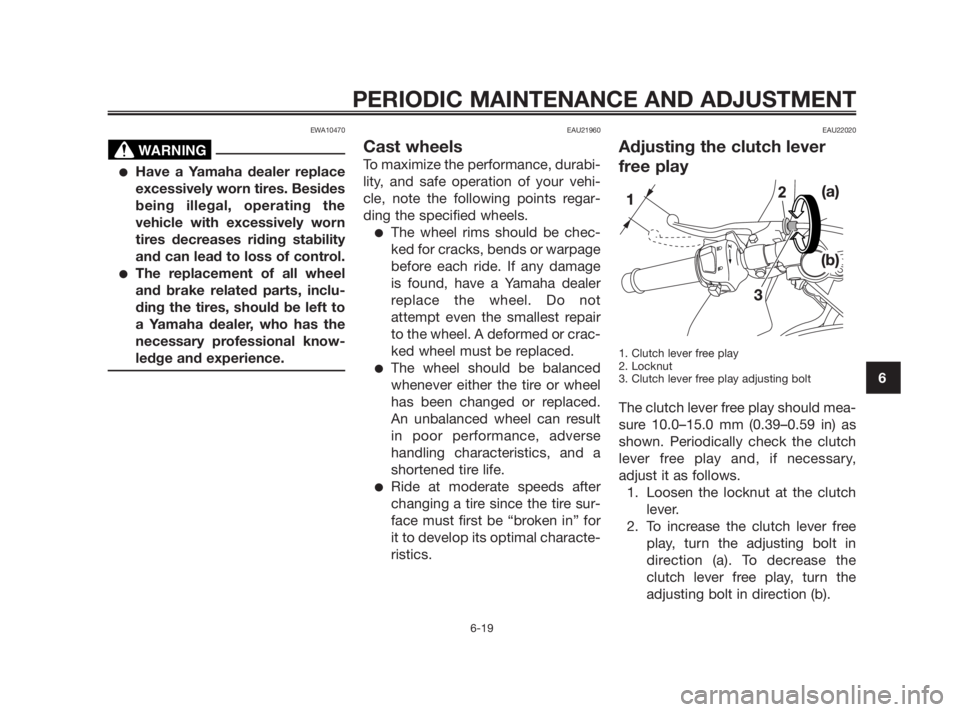rims YAMAHA TZR50 2011 Owners Manual
[x] Cancel search | Manufacturer: YAMAHA, Model Year: 2011, Model line: TZR50, Model: YAMAHA TZR50 2011Pages: 88, PDF Size: 1.83 MB
Page 11 of 88

1
SAFETY INFORMATION
1-4
that these aftermarket companies
produce. Therefore, Yamaha can neit-
her endorse nor recommend the use
of accessories not sold by Yamaha or
modifications not specifically recom-
mended by Yamaha, even if sold and
installed by a Yamaha dealer.
Aftermarket Parts, Accessories,
and Modifications
While you may find aftermarket pro-
ducts similar in design and quality to
genuine Yamaha accessories, recog-
nize that some aftermarket accesso-
ries or modifications are not suitable
because of potential safety hazards to
you or others. Installing aftermarket
products or having other modifica-
tions performed to your vehicle that
change any of the vehicle’s design or
operation characteristics can put you
and others at greater risk of serious
injury or death. You are responsible
for injuries related to changes in the
vehicle.
Keep the following guidelines in mind,
as well as those provided under “Loa-
ding” when mounting accessories.●Never install accessories or carry
cargo that would impair the perfor-
mance of your motorcycle. Care-
fully inspect the accessory before
using it to make sure that it does
not in any way reduce ground cle-
arance or cornering clearance, limit
suspension travel, steering travel
or control operation, or obscure
lights or reflectors.
• Accessories fitted to the hand-
lebar or the front fork area can
create instability due to impro-
per weight distribution or
aerodynamic changes. If
accessories are added to the
handlebar or front fork area,
they must be as lightweight as
possible and should be kept to
a minimum.
• Bulky or large accessories may
seriously affect the stability of
the motorcycle due to aerody-
namic effects. Wind may
attempt to lift the motorcycle,
or the motorcycle may become
unstable in cross winds. These
accessories may also cause
instability when passing orbeing passed by large vehicles.
• Certain accessories can displa-
ce the operator from his or her
normal riding position. This
improper position limits the free-
dom of movement of the opera-
tor and may limit control ability,
therefore, such accessories are
not recommended.
●Use caution when adding electri-
cal accessories. If electrical
accessories exceed the capacity
of the motorcycle’s electrical sys-
tem, an electric failure could
result, which could cause a dan-
gerous loss of lights or engine
power.
Aftermarket Tires and Rims
The tires and rims that came with your
motorcycle were designed to match
the performance capabilities and to
provide the best combination of
handling, braking, and comfort. Other
tires, rims, sizes, and combinations
may not be appropriate. Refer to
page 6-17 for tire specifications and
more information on replacing your
tires.
5WX-F819D-E3 15/11/08 15:27 Página 11
Page 55 of 88

EWA10470
●Have a Yamaha dealer replace
excessively worn tires. Besides
being illegal, operating the
vehicle with excessively worn
tires decreases riding stability
and can lead to loss of control.
●The replacement of all wheel
and brake related parts, inclu-
ding the tires, should be left to
a Yamaha dealer, who has the
necessary professional know-
ledge and experience.
EAU21960
Cast wheels
To maximize the performance, durabi-
lity, and safe operation of your vehi-
cle, note the following points regar-
ding the specified wheels.
●The wheel rims should be chec-
ked for cracks, bends or warpage
before each ride. If any damage
is found, have a Yamaha dealer
replace the wheel. Do not
attempt even the smallest repair
to the wheel. A deformed or crac-
ked wheel must be replaced.
●The wheel should be balanced
whenever either the tire or wheel
has been changed or replaced.
An unbalanced wheel can result
in poor performance, adverse
handling characteristics, and a
shortened tire life.
●Ride at moderate speeds after
changing a tire since the tire sur-
face must first be “broken in” for
it to develop its optimal characte-
ristics.
EAU22020
Adjusting the clutch lever
free play
1. Clutch lever free play
2. Locknut
3. Clutch lever free play adjusting bolt
The clutch lever free play should mea-
sure 10.0–15.0 mm (0.39–0.59 in) as
shown. Periodically check the clutch
lever free play and, if necessary,
adjust it as follows.
1. Loosen the locknut at the clutch
lever.
2. To increase the clutch lever free
play, turn the adjusting bolt in
direction (a). To decrease the
clutch lever free play, turn the
adjusting bolt in direction (b).
WARNING
PERIODIC MAINTENANCE AND ADJUSTMENT
6-19
6
5WX-F819D-E3 15/11/08 15:27 Página 55